WAY OF BUDO
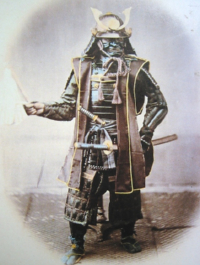 Budō (武道)
Budō (武道)
Budō (武道) is a Japanese term describing martial arts. In English, it is used almost exclusively in reference to Japanese martial arts.Budō is a compound of the root bu (武:ぶ), meaning war or martial; and dō (道:どう), meaning path or way. Specifically, dō is derived from the Buddhist Sanskrit mārga (meaning the „path” to enlightenment).
The term refers to the idea of formulating propositions, subjecting them to philosophical
critique and then following a ‘path’ to realize them. Dō signifies a „way of life”. Dō in the Japanese context, is an experiential term, experiential in the sense that practice (the way of life) is the norm to verify the validity of the discipline cultivated through a given art form.
The modern budō has no external enemy, only the internal enemy, one’s ego that must be fought (state of Muga-mushin).
Similarly to budō, bujutsu is a compoundof the roots bu (武), and jutsu (術:じゅつ), meaning technique Thus, budō is most often translated as „the way of war”, or „martial way”, while bujutsu is translated as „science of war” or „martial craft.” However, both budō and bujutsu are used interchangeably in English with the term „martial arts”. Budo and bujutsu havequite a delicate difference; whereas bujutsu only gives attention to the physical part of fighting (how to best defeat an enemy), budo also gives attention
to the mind and how one should develop oneself. Modern budo uses aspects of the lifestyle of the samurai of feudal Japan and translates them to self-development in modern life.
道 Dō (Way)
A Dō (道) is any one of a number of spiritual, martial, or aesthetic disciplines that evolved in Japan and Korea. The term „Dō” is borrowed from the Chinese philosophical concept ofTao (Dao), a word meaning ‘way’, ‘path’, ‘route’, or sometimes more loosely, ‘doctrine’ or ‘principle’. Within the context of traditional East Asian philosophy and religion, Dō is a metaphysical concept signifying the primordial essence or fundamental nature of the universe.
In Japanese, a Dō implies a body of knowledge and tradition with an ethic and an aesthetic, and having the characteristics of specialization (senmonsei), transmissivity (keishōsei),normativity (kihansei), universality (kihensei), and authoritativeness (ken’isei).
List of Japanese Dō’s
Bushidō (武士道), the Way of the warriorThe samurai moral code.
Gendai budō (現代武道) modern warrior Way.The group of martial disciplines that arose after the Meiji restoration.
Karate or karate-dō (空手道) the Way of the empty hand Bare hand fighting.
Judo (柔道) the „gentle way”.A grappling martial art.
Kendo (剣道) the Way of the swordTraditional Japanese fencing.
Aikido (合気道) the Way of harmonious spiritCompassionate hand-to-hand fighting
Taidō (躰道) the Way of the body.Hand-to-hand fighting evolved from Okinawan karate
Iaido (居合道) the Way of harmonious life.A Japanese martial art associated with the smooth, controlled movements of drawing the sword
Jōdō (杖道) the Way of the jō.Wooden staff fighting
Jūkendō (銃剣) the Way of the bayonetBayonet fighting
Kyūdō, (弓道) the Way of the bow.Zen archery
Nanbudō (南武道) the Way of the Nan warrior. Hand-to-hand fighting recently evolved from karate
Kyushindō the Way of longing for knowledge of the fundamental nature of anything. Japanese-inspired Western school of hand-to-hand fighting
Hojōjutsu martial art.A Japanese martial art of restraining a person using cord or rope
Yoseikan Budō (養正館武道) Appreciation of incense, the teaching truth place warrior Way.Comprehensive martial art with ancient roots.
Chadō (茶道) or sadō, or chanoyu, the Way of tea.The Japanese tea ceremony
Shodō (書道) the Way of writing.Traditional Japanese brush calligraphy
Kadō (華道) or Ikebana, the Way of flowersFlower arrangement
Kōdō, (香道) the Way of incense/fragrance
Shinto (神道) the Way of the gods.The native religion of Japan
List of Korean Dō’s
The word „道” is used in quite the same way in Korean language and culture, and is pronounced identically
with its Japanese cognate as Dō.
Taekwon-Do(태권도; 跆拳道) the Way of the foot and the fist.a Korean martial art with roots in Taekkyon and Karate
Kumdo(검도; 劍道) the Way of the Sword.Korean fencing with roots in Japanese Kendo
Hapkido(합기도; 合氣道) the Way of the harmonious spirit.a Korean martial art which shares history with Japanese Aikido
Seodo(서도; 書道) the Way of writingAn alternate name for Korean brush calligraphy
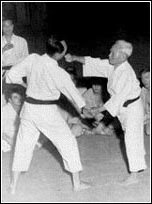 Karate Do ? (空手道)
Karate Do ? (空手道)
Karate is not for an attack.Karate Do is not a martial art whose ultimate goal is to win. Its goal is to strive to improve your character as best you can by tiding over tangible and
intangible ordeals and by training as hard as possible.Karate (空手) literally means „empty hand”. However, the word”karate” written with homophonic ideograms means „China hand” ,rather than „empty hand”. It is also sometimes called „the way of the empty hand” (空手道 karatedō).Modern karate originated in Okinawa, formerly known as the Ryūkyū Kingdom, but now a part of present-day Japan. Karate is a fusion of pre-existing Okinawan martial arts, called „te”, and Chinese martial arts. It is an art that has been adopted and developed by practitioners on the Japanese main island of Honshu.
Karate’s route to Honshu began with Gichin Funakoshi (船越 義珍 Funakoshi Gichin, 1868–1957), who is called the father of modern karate, and is the founder of Shotokan karate. Although some Okinawan karate practitioners were already living and teaching in Honshū,Funakoshi gave public demonstrations of karate in Tokyo at a physical education exhibitionsponsored by the ministry of education in 1917, and again in 1922. As a result, karate training was subsequently incorporated into Japan’s public school system.
It was also at this time that the white uniforms and the kyū/dan ranking system (both originally implemented by judo’s founder, Kano Jigoro) were adopted.Karate practice is primarily characterized by linear punching and kicking techniques executed from a stable, fixed stance. Many styles of karate practiced today incorporate the forms (kata) originally developed by Funakoshi and his teachers, and many different weapons originally used as farm implements by the peasants of Okinawa, such as the sai, sickle (kama), and quarterstaff (bō).
Many modern karate practitioners also participate in full, light, and no-contact competitions.
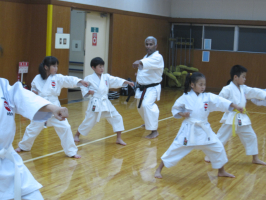 Kihon (基本)
Kihon (基本)
Kihon is a Japanese term meaning „basics” or „fundamentals.” The term is used to refer to the basic techniques that are taught and practiced as the foundation of most Japanese martial arts.
The practice and mastery of kihon is essential to all advanced training, and includes the practice of correctbody form and breathing, while practicing basics such as stances, punches, kicks, blocks, and thrusts, but it also includes basic representative kata.
Kihon is not only practicing of techniques, it is also the karateka fostering the correct spirit and attitude at all times.Kihon techniques tend to be practiced often, in many cases during each practice session.
They are considered fundamental to mastery and improvement of all movements of greater complexity.
Kihon in martial arts can be seen as analogous to basic skills in, for example, basketball. Professional NBA players continue to practice dribbling, passing, free throws, jump shots, etc. in an effort to maintain and perfect the more complex skills used during a basketball game.
Styles of karate differ greatly in the emphasis placed on kihon. Kihon may be practiced as „floor exercises”, where the same technique or combination is repeated multiple times as the students move back and forth across the floor. Japanese kihon training is notorious for extended periods of kihon training.
This style of practice is believedto ingrain the techniques into the muscle memory of the karateka.
Somestyles employ „kihon kata” in teaching beginners.
Additionally, kihon may take the form of prearranged partner drills whereby two students face each other and alternate execution of a technique. This approach combines repetition with training in distancing.
Targets for punching and kicking, such as bags, shields, or dummies, are generally used at more advanced stages of kihon trainingto strengthen muscles, bones,and skin.The basic techniques of blocking, punching, striking and kicking are both the beginning of karate and the altimate goal.
Although only a matter of months may be sufficient to learn them, complete mastery may not come even after a lifetime of training.The student must practice regularly, with maximum concentration and effort in the execution of each and every movement.This will not be sufficient, however, unless the techniques are scientifically sound and the training systematic and properly scheduled. To be effective, training must be conducted on the basis of correct physical and physiological principles.
It may come as a surprise to many to know that the techniques created and refined through long and continuous practice by the early karate student have been found to accord with modern scientific principles.
And the more they are studied, the more this proves to be true. This is not to say that there are no unsolved problems, but thesemustawait further study. Further refinement of karate is quite probable, as techniques are analyzed in an unceasing effort to improve them through a scientific approach.
In order to benefit from his training, the student should have a good understanding of following primary points.
The weapons of karate-do are various parts of the human body.Every part that can be effective in defense or offense is used,It is in this respect that karate-do is differentfrom the other martial arts.
Systematic training is the only way to develop weapons that will be ready for use at any time,in any place, in any situation.It is most importantthat training of every part of the body be continuous and methodical.
Intensive training alone is not abequate to convert the parts of the body into powerful weapons.
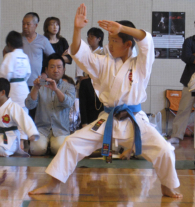 Tachikata(立ち方) Stance
Tachikata(立ち方) Stance
Fundamental to the improvement of one’s karate technique is the acquisition of correct and balanced from.A strong technique is born from a firm, sure-footed stance. Whethre the technique is offensive or defensive, it will not be effective if the body lacks balance and stability.
The ability to counter an attack under any circumstances depends largely on the maintenance of correct form. For techniques to be powerful, fast, accurate and smoothly executed, they must be launchedfrom a strong and stable base.
In karate stance (tachikata) refers to the position of the lower body, the hips and the legs, which literally carry the upper body. Thus techniques are at their best when form is at theoptimum.
The moment when this is important is the instant in which a techniqueis executed. Good form is not rigid.
Overconcentration on maintaining a firm and stable position will result in loss of mobility, whichis necessary for the succeeding movement. It is well to remember thatskyscrapers can be built only on a solid foundation.
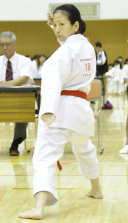 Requirements of Good Stance – The basis of executing a technique is correct stance plus balance and the harmonious coordination of parts of the body, and all mustwork together at the same time.
Requirements of Good Stance – The basis of executing a technique is correct stance plus balance and the harmonious coordination of parts of the body, and all mustwork together at the same time.
In this way, techniques become fast and powerful.The delicate control that is required depends onand is guided by good stance.
Classification of Stances – Stances can be divided into two types according to the way the knees are used in relation to the center of gravity.
1. Outside tension stance, the knees are pressed strongly outward from the mid line connecting the body’s center of gravity and the floor,as in Zenkutsu dachi, Kiba dachi, Kokutsu dachi and Shiko dachi.
2. Inside tension stance, the knees are twisted inward, as in Uchihachuji dachi, Sanchin dachi and Nekoashi dachi.
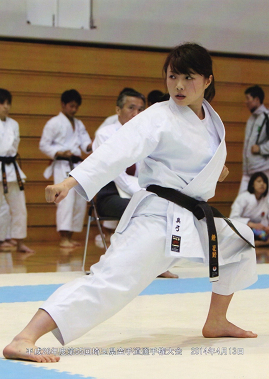 The Important Points
The Important Points
Spreading the Knees
Imagine a line connecting the knees and extending on outward to the side. Spread the knees strongly outward on the extended line.
Knees and Toes
Whatever the stance, and the toes of each leg should point in the same direction.
Knees and Ankles
Knees and ankles must be bent sufficiently and strongly
Soles
The entire surface of the soles should be in reliable contact with the floor. The feeling is that of strong adhesion.
Position of the Hips
According to the stance,the position of the hips must be accurately differentiated.
Center of Gravity
For strength and stability, it is necessity to have the feeling that the connecting the navel and the anus is as shorts as possible.
The height of the center of gravity is also a factor. The lower the center of gravity, the more stables the stance.
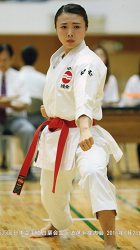 Katachi (形) Form
Katachi (形) Form
Correct form is always closely related to the principles of physics and physiology.
Prerequisites of correct form are good balance, a high degree of stability and the order of movements of each part of the body, since movements are made in quick succession in a short period of time.
This is specially true in karate because punching and kicking are vital to the art.
The need for good balance can be seen particularly in kicking,where the body is usually supported by one leg.
To withstand the great impact when a blow is landed, stability of all joints in he arms and hands is necessary.With changing situations and different technique, the center of gravity changes, shifting to the left, right, front, back.
This cannot be done unless the nerves and muscles are well trained. Again, standing on one foot for too long will open one attack, so balance must be constantly shifted from one foot to the other. The karate student must mothavoid giving an opening and be prepared for the next attack.
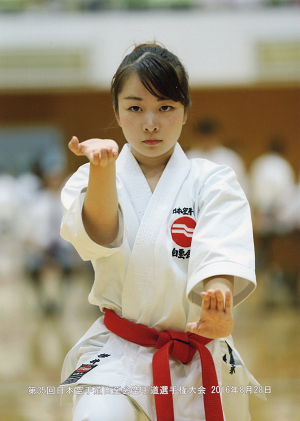 Uke no Go Gensoku (受けの五原則)
Uke no Go Gensoku (受けの五原則)
The following principles are what all Karateka practitioners strive to master.Although it is an endiess task…
Rakka : Like a falling flower
To block with such force that if the technique were applied to the trunk of a tree it would lose all of its flowers.A block should be executed so decisively that it not only halts an opponent’s attack but utterly defeats it with a single technique.
Ryusui : Like flowing water
To flow with your opponents movements,using them against him and as an aid to your defense respondto your oppnent using fluid movement.
Kusshin : „Darting out and in”
Control of an attack that uses body movement originating in the knees.
Keep your spine straight and useyour knees to control your height, giving you balance and the strength of your legs so that little effort is required to control the attack.Springing,A reflexive, darting „out and in” kind of body shifting from anyangle.
Tenshin : Tai sabaki, (rolling the body by stepping out)
Essentially avoiding your opponent’s attack using body movement.Stepping out in all directions.
Hangeki : Counter attack
When the need arises,respond to your opponents attacks with decisivepowerful counter-attacks. By utilizing the first four principles you may never need to implement the fifth,but if required you should apply you whole mind and body to the counter.
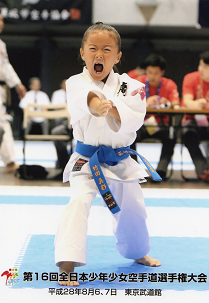 Kiai (Spirit-meeting or Energy-shout)
Kiai (Spirit-meeting or Energy-shout)
The Kiai is the shout at the end of a technique and in conjunction with the expulsion of air (Kime) Will maximize the power of the movement. It also had the effect of surprising an opponent and may momentarily paralyze their response.
The concept of KI is at the roof of oll martial arts and Japanese philosophy.
KI is the spirit and energy along with the breath meeting AI at the moment of impact.
Developing your KIAI is very important. It is not just a shout or a screech from the throat. If you put your hand on the stomach and cough you will feel the muscles of your abdomen contract. This in fact is the start of your ‘KIAI’.
First understand the principles and the breathing method Kime as explained, then replace the biting action with your shout ‘KIAI’ It will start as a growl from the pit of the stomach but when completed the sound produced will vary from one to another.
Kokyu (呼吸) Breathing
Breathing is coordinated with the execution of a technique, specifically inhaling when blocking, exhaling when focusing technique is executed, and exhaling when successive techniques are performed.
Breathing should not be uniform; it should change with changing situations. When inhaling, fill the lungs full, but when exhaling do not expel all the air.
Leave about 20 percent in the lungs. Exhaling completely will leave the body limp. One will not be able to block even a weak blow, nor will be able to prepare for the next movement.
The karateka should coordinate breathing with her techniques. Breathing enhances the karateka’s ability to relax and concentrate maximum power in her techniques. Correct breathing – fully exhaling when finishing a strike, for example – is necessary to developing kime. The karateka should not breathe in a uniform manner; her breathing should change with the situation. Proper inhaling fills the lungs completely.
Proper exhaling leaves the lungs about 20 percent full – exhaling completely makes the body limp, leaving the karateka vulnerable to even a weak attack.
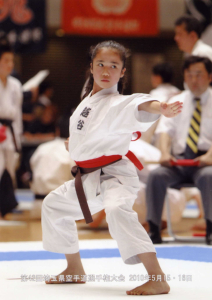 Kime (決め)
Kime (決め)
Kime is a Japanese word. It is the noun form of the verb „kimeru,” which means „to decide,” „to conclude,” or” focusing” ,etc In English, its general meaning is „deciding.” or „focusing”Kime is a commonly-used Japanese martial arts term.
In karate it can mean „power” and/or „focus,” describing the instantaneous tensing at the correct moment during a technique.
The tension at this time is mostly focused on the dantian („hara”) and abdomen.
In otherbudō, the term refers to attacking a pressure point.In all cases, certain finality is implied.Without breath there is on life. Without Kime your karate is lifeless.
It is essential that you understand that all karate techniques must be performed with Kime.Kime is the focusing of mental energy,breathing and physical force culminating in a single striking point.Karate is not whole without all these elements.
The key to kime is the breathing.
Any physical activity requires correct breathing,witch works with the body not against it.The grunts and groans athletes make are not for effect; a student is using his breathing along with his muscles to explode with maximum effect, producing the most potent force possible.No effort is wasted.
There are various methods of breathing, but the basic method for beginners is: ‘One breath one technique’.
In a relaxed but controlled manner breathe out through a slightly opened ,mouth complete the breath and technique at the same moment closing your mouth instantly as if biting. Simultaneously tense the abdomen, locking the rest of your muscles for a fraction of a second before relaxing and breathing in normally.As you tense and lock the muscles of the abdomen, the buttocks should be clenched so that the abdomen lifts up and forward
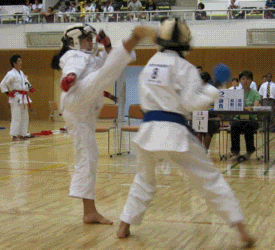 Maai (間合い)
Maai (間合い)
Openings, initiative, and timing are deeply interrelated con cepts applicable to self defense and competitive combat.They each
describe different considerations relevant to successfully initiating or countering an attack.
Openings (隙 suki) are the foundation of a successful attack.
Although possible to successfully injure an opponent who is ready to receive an attack, it is obviously preferable to attack
when and where one’s opponent is open.
What it means to be open may be as blatant as an opponent becoming tired and lowering their guard (as in physically loweringtheir hands), or as subtle as a momentary lapse in concentration.
In the classical form of combat between masters, each would stand almost entirely motionless until the slightest opening was spotted; only then would they aunch as devastating an attack asthey could muster, with the goal of incapacitating their opponent with a single blow.
In Japanese martial arts, „initiative” (先 sen) refers to „the decisive moment when a killing action is initiated.
„There are two types of initiative in Japanese martial arts, early initiative (先の先sen no sen), and late initiative (後の先 go no sen). Each type of initiative complements the other, and has different advantages and weaknesses.
Early initiative is the taking advantage of an opening in an opponent’s guard or concentration (see suki, supra).
To fully take the early initiative, the attack launched must be with total commitment and lacking in any hesitation, and virtually ignoring the possibility of a counter-attack by the opponent.
Late initiative involves an active attempt to induce an attack by the opponent that will create a weakness in the opponent’s defenses, often by faking an opening that is too enticing for the opponent to pass up.
All of the above concepts are integrated into the idea of the combat interval or timing (間合い maai).
Maai is a complex concept, incorporating not just the distance between opponents,but also the time it will take to cross the distance, and angle and rhythm of attack. It is specifically the exact „position” from which one opponent can strike the other, after factoring in theabove elements.
For example, a faster opponent’s maai is farther away than a slower opponent. It is ideal for one opponent to maintain maai while preventing the other from doing so.
The Three Attacks
1. Go no sen – meaning “late attack” involves a defensive or counter movement in response to an attack.
2. Sen no sen – a defensive initiative launched simultaneously with the attack of the opponent.
3. Sensen no sen – an initiative launched in anticipation of an attack where the opponent is fully committed to their attack and thus psychologically beyond the point of no return.
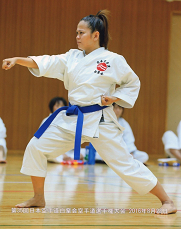 Koshi (腰) Hips
Koshi (腰) Hips
The hips are located at approximately at the center of the human body,and their movementplays a crucial role in the execution of various types of karate techniques.
The lower abdomen, particularly the rotation of the hips, which adds to the power of the upperbody, creates the explosive power of the focusing blow.
Besides being a source of power, the hips provide the basis for a stable spirit, correct form and maintenance of good balance. In karate, the advice is often given to „punch with your hips”, „kick with your hips”, „strikewith your hips” and „block with your hips.Rotating the hips.
A technique cannot be sharp and decisive unless the rotation of the hips is utilized to the fullest.
Basically, training in rotation of the hips begins with fast movementon a fairly large scale. As one advances in skill, the rotation should be fast but on a small scale.Eventually the feeling should be one of the hips turning in a sharp cutting movement.
As for techniques, there are those with a fast, strong, large movement and those with a rapid, sharp, small movement. It is essential to learn which technique is appropriate to which situation.This can only be done by accumulating practice. Important in beginning training is the mastery of large-scale technique that is fast,strong, up to the standard and that travels thecorrect route.
The faster the rotation of the hips, the better, for this gives an abundance of speed to the technique. The principle of the rotation is the same as that of a spring.
The tighter the spring is wound, the greater will be the force when it is released. Rotating the hips (to the half-front-facing position) and blocking is like winding the spring.
Rotating the hips the other way (to the original position) and punching is like releasing the spring.
Withdrawing arm (hiki-te)-Hip rotation (block)-Reversehip rotation-Punch.
The Important Points
1. Keep the hips horizontal to the floor, and rotate them smoothly.
2. Do not allow either hip to raise; always keep them level.
3. Do not turn the shoulders only. Turn the upper body smoothly and in unison with the hips.
4. Always keep the torso upright, taking care that the buttocks do not protrude to the rear.
In many Karate techniques the power does come from the rotation of the hips. To understand it, try swinging a baseball bat without allowing your hips to rotate.
You can’t generate power. In the case of the baseball bat the hip rotation comes quite (but not completely) naturally. Much of Karate training is about leaning how to employ the hip rotation to create speed, power and disguise in the techniques. I can’t begin to explain it, because you need to train in Karate for a few years to learn it. If I could explain it here nobody would need to train. As for the legs, the legs support the hips so yes they are very much involved!The hips are a crucial, yet oft-neglected component in executing karate techniques.Hip rotation adds power to the upper body, and is thus essential to strong blocks and punches.
The hips’ proximity to the body’s center of gravity make them the foundation of strong, stable movements, good balance, and proper form.
The karateka cannot move as smoothly, quickly, or powerfully if the hips are passive. For this reason, teachers often remind their students to „block with your hips,” „punch with your hips,””strike with your hips” and „kick from your hips.”
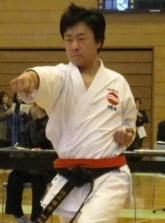 Hiki te (引き手) The Withdrawing Hand
Hiki te (引き手) The Withdrawing Hand
The withdrawing hand (Hikite) leads rotation of the hips. When executing a technique, the withdrawing hand must move strongly, quickly and sufficiently. If not, the technique will not reach its maximum effectiveness. Another important point is that both arms
must move at exactly the same time.
If a technique is being executed with the right hand, it is usual for the left elbow to be drawn straight back. However, when biocking in the half-front-facing position, it is better if the elbow comes back somewhat in the direction of the spine, rather than straight back.
When striking in a wide arc, the withdrawing arm should also describe a wide arc. In other words, if the technique is executed in a straight line, the otherarm withdraws in a straight line. If the technique is arclike, the other arm travels in an arc.
It is not too much to say that exellent techniques are born from a strong, fast withdrawing arm.
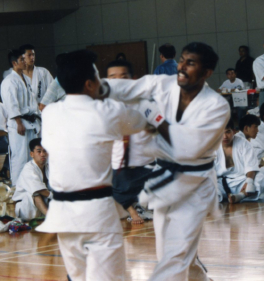 Rhythm and Timing
Rhythm and Timing
In any sport, the performance of a top athlete is very rhythmical. The applies olso in Karate. Whether it is a deciisive technique-punching, kicking, blocking or counter attac king, and no matter how strong or accurate the technique may be otherwise,timing must be precise.Being the least bit early or the least is nothing but a mistake.
The moment a technique is completed, you should take a new stance, one in whi
States of mind: empty, immovable, remaining, and beginner’s
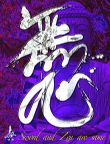 Mushin (無心)
Mushin (無心)
Mushin (無心; Chinese wúxīn; English translation „no-mindedness”) is a mental state into which very highly trainedmartial airist are said to enter duringcombat. They also practice this mental state during everyday activities. The term is shortened from mushin no shin (無心の心), a Zen expression meaning mind of no mind and is also referred to as the state of „no-mindness”. That is, a mind not fixed or occupied by thought or
emotion and thus open to everything. For the origin of the mushin concept, see Muga-mushin. It is some what analogous to flow experienced by artists deeply in a creative process.
Mushin is achieved when a person’s mind is free from thoughts of anger,fear or ego during combat or everyday life.There is an absence of discursive thought and judgment, so the person is totally free to act and react towards anopponent without hesitation and without disturbance from such thoughts. At this point, a person relies not on whatthey think should be the next move, but what is their trained natural reaction or what is felt intuitive. It is not a state of relaxed, near-sleepfulness, however. The mind could be said to be working at a very high speed, but with no intentions, plans or direction. In analogy a clear mind is compared to a still pond, which is able to clearlyreflect the moon and trees. But just as waves in the pond will distort the picture of reality, so will the thoughts we hold onto disrupt the trueperception of reality.
A martial artist would likely have to train for many years to be capable of maintained mushin.This allows time for combinations of movements and exchanges of techniques to be practised repetitively many thousands of times, until they can be performed spontaneously, without conscious thought, thus changing your natural reactions to be more effective in combat or whatever else you may be doing. If he is capable of truly listening to his teacher, however, he could attain this level in only a few years.Some masters believe that mushin is the state where a personfinally understands the uselessness of techniques and becomes truly free to move. In fact, that person will no longereven consider themselves as „fighters” but merely living beings moving through space.
The legendary Zen masterTakuan Soho said:
The mind must always be in the state of ‘flowing,’ for when it stops anywhere that means the flow is interruptedand it is this interruption that is injurious to the well-being of the mind. In the case of the swordsman, it means death. When the swordsman stands against his opponent, he is not to think of the opponent, nor of himself, nor of his enemy’ssword movements. He just stands there with his sword which, forgetful of all technique, is ready only to follow thedictates of the subconscious. The man has effaced himself as the wielder of the sword. When he strikes, it is not the man but the sword in the hand of the man’s subconscious that strikes.
However, mushin is not just a state of mind that can be achieved during combat. Many martial artists, particularlythose practising Japanese martial arts such askarate or iaijutsu, train to achieve this state of mind during kata so that a flawless execution of moves is accomplished that they may be achieved during combat or at any other time. Once mushin is attained through the practicing or studying of martial arts (although it can be accomplished through other arts or practices that refine the mind and body), the objective is to then attain this same level of completeawareness in other aspects of the practitioner’s life.
Mushin is very closely related to another state of mind known as heijoshin, wherein a complete balance and harmony is attained in one’s life through mental discipline.Musashi Miyamoto, the great swordsman, alluded to these mentalstates briefly,and his conversations with Jotaro were often repeated in Japanese folklore as lessons to be learned for the practice of one’s life. Mushin and heijoshin are closely related to the teachings of Budddhism, specifically Zen teachings, and indeed the more mental aspects and attributes draw heavily from these philosophies.
Fudōshin (不動心)
Fudōshin (不動心) is a state of equanimity or imperturbability (literally and metaphorically, „immovable mind””immovable heart”or „unmoving heart”). It is a philosophical or mental dimension to a (usually Japanese) martial art which contributes to the effectiveness of the advanced practitioner.
Fudoshin:
A spirit of unshakable calm and determination,courage without recklessness,rooted stability in both mental and physical realms.Like a willow tree,powerful roots deep in the ground and a soft, yielding resistance againstthe winds that blow through it.
Fudo mvoo is found in Shingon Buddhism as a guardian deity, (and patron of martial arts) who is portrayed as carrying a sword in his right hand (to cut through delusions and ignorance) and a rope in his left (to bind „evil forces” and violent or uncontrolled passions and emotions).
Despite a fearsome appearance, his attributes of benevolence and servitude to living beings are symbolizedby a hairstyle associated with the servant class.
Zanshin (残心)
Zanshin (残心) is a term used in the Japanese martial arts. It refers to a state of awareness – of relaxed alertness.The literal translation of zanshin is „remaining mind”.In several martial arts, zanshin refers more narrowly to the body’s posture after a technique is executed.
In various martial arts
In Karate, zanshin is the state of total awareness.It means being aware of one’s surroundings and enemies, while being prepared to react.
In Kyudozanshin means the body posture after the loosing of an arrow; the posture is intended to reflect the higher meaning of zanshin, which is a mental aspect maintained before, during, and after an action.
In the context of Kendo,zanshin is the continued state of spirit, mental alertness and physical readiness to meet the situation (such as an opposing attack) that must be maintained when one returns to kamae after attacking. It is one of the essential elements that define a good attack.
During the practice of Aikido,the usual method of practicing zanshin is to focus on the just-thrown uke, or opponent, while holding kamae and maintaining awareness in case there are additional attacks or attackers.
In Iwama Style training, zanshin is practiced as general awareness of one’s surroundings, of which uke is just a small part
Shoshin(初心)
Shoshin(初心)is a concept in Zen Buddhism meaning Beginner’s Mind. It refers to having an attitude of openness, eagerness, and lack of preconceptions when studying a subject, even when studying at an advanced level, just as abeginner in that subject would. The term is especially used in the study of Zen Buddhism and Japanese martial arts.
Beginner’s Mind,which reflects a saying of his regarding the way to approach Zen practice: In the beginner’smindthere are many possibilities, in the expert’s mind there are few.
Shoshin also means „Correct Truth” and is used to denote a correct or perfect signature on art works Shoshin Mei.This is opposed to fake signature, „Gimei” (bad Mei). The term can be used for any thing or person who is perfectly genuine.
Kokoro (心:こころ)
Kokoro (心:こころ) is a concept that crosses through many martial arts, but has no single discrete meaning. Literally translating as „heart”, in context it can also mean „character” or „attitude.”
Character is a central concept in karate, and in keeping with the do nature of modern karate, there is a great emphasis on improving oneself. It is often said that the art of karate is for self-defense; not injuring one’s opponent is the highest expression of the art.
Some popularly repeated quotes implicating this concept include: „The ultimate aim of Karate lies not in victory or defeat, but in the perfection of the character of its participants.” Gichin Funakoshi
What is a ryu ?
The easy answer is that it roughly translates to „style,” or „school,” as in a certain way of doing something. But you didn’t expect Furyu the Budo Journal to end with that pat answer, did you? Of course not. Here’s the harder, more involved answer. Certainly „style” or „school” is a good shorthand definition of ryu. But upon further reflection, ryu appended to a martial arts system encompasses much more than just a „style” or way of doing things.
Japanese martial arts are often classified and codified into ryūha. Usually a given style will have its own curriculum, ranks and licensure system. These may be based on the parent style or a combination of sources that form the background of the system.
The name of a style may have particular meaning or may simply be a location. Toyama-ryū is named for the Toyama Military Academy in Japan. In contrast, Gōjū-ryū is the ‘hard-soft’ style, which indicates both characteristic techniquesand thematic elements that form a ‘signature’ of the style.
Some times this is merged or confused with the name of the Dojo (as is the case with Shōtōkan-ryū karate.Shoto (松濤 Shōtō), meaning „pine-waves” (the movement of pine needleswhen the wind blows through them), was Funakoshi’s pen-name, which he used in his poetic and philosophical writings and messages to his students. The Japanese kan (館 kan) means „house” or „hall”. In honor of their sensei, Funakoshi’s students created a sign reading shōtō-kan, which they placed above the entrance of the hall where Funakoshi taught. Gichin Funakoshi never gave his style a name, just calling it karate.).
High-level practitioners of an established style may splinter off and form their own derivative styles based on their own experience or interpretation. Sometimes this is encouraged by the parent style, sometimes it represents an ideological schism between senior members of the style. Sometimes, it is done simply for ‘marketing’ reasons or to adjust a system to modern times.
There is no universal licensing or ranking system across all ryūha. A high ranking person or black belt in one style does not necessarily correspond to a high level understanding in another style or group of styles.
There are many ryūha inJapan that have existed for many hundreds of years, as well as many more that were created in modern times.The concept of organizing a codified system is obviously not a Japanese or outwardly Asian one, though many international or foreign styles may adopt the nomenclature and systemization of koryū bujutsu ryūha in order to add an air of mystique or legitimacy to their system, or simply as a method to show their roots and background.
Hard & Soft(剛法 gōhō), (柔法, jūhō)
There are two underlying strategic methodologies to the application of force in Japanese martial arts.
One is the hard method (gōhō), and the other is the soft method (jūhō). Implicit in these concepts is their separate but equal and interrelated nature, in keeping with their philosophical relationship to the Chinese principles of yin and yang.
The hard method is characterized by the direct application of counter-force to an opposing force.
In practice, this may be a direct attack, consisting of movement directly towards the opponent, coinciding with a strike towards the opponent. A defensive technique where the defender stands their ground to block or parry (directly opposing the attack by stopping it or knocking it aside) would be an example of a hard method of defense. Hard method techniques are generally conceptualized as being linear.
Shotokan is often regarded as a ‘hard’ and ‘external’ martial art because it is taught that way to beginners and coloured belts to develop strong basic techniques and stances.
The soft method is characterized by the indirect application of force, which either avoids or redirects the opposing force. For example, receiving an attack by slipping past it, followed by adding force to the attacker’s limb for the purpose of unbalancing an attacker is an example of soft method. Soft method techniques are generally conceptualized as being circular.
Gōjū-ryū (剛柔流), (Japanese for „hard-soft style”) is one of the main traditional Okinawan styles of karate, featuring a combination of hard and soft techniques. Both principles, hard and soft, come from the famous martial arts book Bubishi (Chinese: wu bei ji), used by Okinawan masters during the 19th and 20th centuries. Go which means hard, refers to closed hand techniques or straight linear attacks; Ju which means soft, refers to open hand techniques and circular movements.
These definitions give rise to the often illusory distinction between „hard-style” and „soft-style” martial arts. In truth, most styles technically practice both, regardless of their internal nomenclature. Analyzing the difference in accordance with yin and yang principles, philosophers would assert that the absence of either one would render the practitioner’s skills unbalanced or deficient, as yin and yang alone are each only half of a whole.
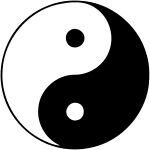 The traditional Taijitu, Yin and Yang symbol, represents the “hard” and the “soft” in a martial art.
The traditional Taijitu, Yin and Yang symbol, represents the “hard” and the “soft” in a martial art.
The Meaning of Shuhari
Shu Ha Ri is a term the Japanese use to describe the overall progression of martial arts training, as well as the lifelong relationship the student will enjoy with his or her instructor.
Shu can either mean „to protect” or „to obey.” The dual meaning of the term is aptly descriptive of the relationship between a martial arts student and teacher in the student’s early stages, which can be likened to the relationship of a parent and child. The student should absorb all the teacher imparts, be eager to learn and willing to accept all correction and constructive criticism.
The teacher must guard the student in the sense of watching out for his or her interests and nurturing and encouraging his or her progress, much as a parent guards a child through its growing years. Shu stresses basics in an uncompromising fashion so the student has a solid foundation for future learning, and all students perform techniques in identical fashion, even though their personalities, body structure, age, and abilities all differ.
Ha is another term with an appropriate double meaning: „to break free” or „to frustrate.” Sometime after the student reaches dan (black belt) level,he or she will begin to break free in two ways.In terms of technique, the student will break free of the fundamentals and begin to apply the principles acquired from the practice of basics in new, freer, and more imaginative ways. The student’s individuality will begin to emerge in the way he or she performs techniques. At a deeper level, he or she will also break
free of the rigid instruction of the teacher and begin to question and discover more through personal experience. This can be a time of frustration for the teacher, as the student’s journey of discovery leads to countless questions beginning with „Why…” At the Ha stage, the relationship between student and teacher is similar to that of a parent and an adult child; the teacher is a master of the art. and the student may now be an instructor to the others.
Ri is the stage at which the student, now a kodansha (high ranking black belt), separates from the instructor having absorbed all that he or she can learn from them. This is not to say that the student and teacher are no longer associated. Actually, quite the opposite should be true; they should now have a stronger bond than ever before, much as a grandparent does with their son or daughter who is now also a parent. Although the student is now fully independent, he treasures the wisdom and patient counsel of the teacher and there is a richness to their relationship that comes through their shared experiences. But the student is now learning and progressing more through self-discovery than by instruction and can give outlet to his or her own creative impulses. The student’s techniques will bear he imprint of his or her own personality and character. Ri, too, has a dual meaning, the second part of which is „to set free” As much as the student now seeks independence from the teacher, the instructor likewise must set the student free.
Shu Ha Ri is not a linear progression. It is more akin to concentric circles, so that there is Shu within Ha and both Shu and Ha within Ri. Thus, the fundamentals remain constant; only the application of them and the subtleties of their execution change as the student progresses and his or her own personality begins to flavor the techniques performed. Similarly, the student and teacher are always bound together by their close relationship and the knowledge, experience, culture, and tradition shared between them. Ultimately, Shu Ha Ri should result in the student surpassing the master, both in knowledge and skill. This is the source of improvement for the art as a whole. If the student never surpasses his master, then the art will stagnate, at best. If the student never achieves the master’s ability, the art will deteriorate. But, if the student can assimilate all that the master can impart and then progress to even higher levels of advancement, the art will continually improve and flourish.
